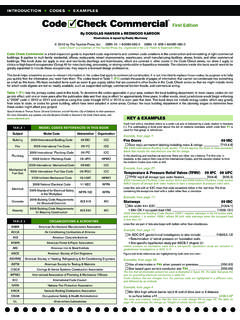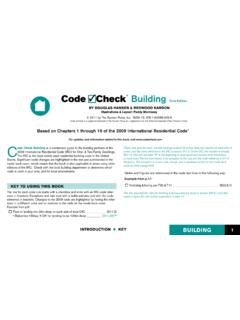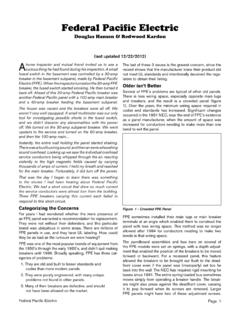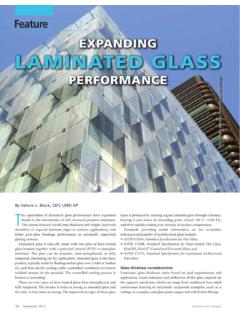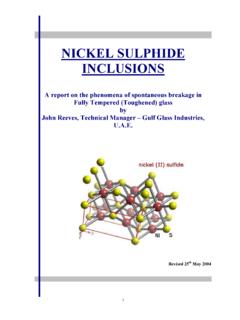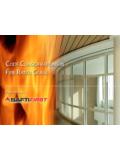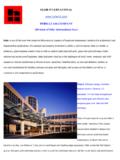Transcription of Safety Glazing by Douglas Hansen - Code Check
1 Safety Glazing - Page 1 of 8 pages Safety Glazing by Douglas Hansen (this article last updated October 19, 2011) glass in some form or another has been used since the dawn of civilization. It appears naturally as obsidian, and the first man-made glass objects date from 3500 BC. The Romans were the first to use glass as an architectural material, with semi-clear glass in windows beginning around 100 BC. glass production was a highly skilled and labor-intensive process. In the middle ages, stained glass was developed by adding different minerals to molten glass , and there are stunning examples of the technology throughout Europe, some dating back to the 13th century.
2 Mirrors with decent effectiveness were not developed until the late 17th century. The technology used for modern mass-production glass is relatively new, dating from around the time of the WWI. The subject of Glazing has many aspects, including emissivity (heat transmission), light transmission, insulating value, leak prevention, wind-resistance, acoustics, sealants, and architectural considerations. The scope of this article is Safety Glazing , and the areas where inspectors look at the hazards posed by Glazing . The Danger When a person accidentally impacts glass , there are two immediate dangers.
3 The first is from lacerations due to the large shards that might slice into the person. There have been numerous instances of persons who have died from injuries such as a severed femoral artery (figure 1). Unless pressure is brought to bear immediately on such a wound, the victim can bleed to death in as little as five minutes. The second danger is from the rebound effect. The first reaction to impacting glass is to pull back. By then the glass is broken, and during the rebound, the person is pulling away from the sharp broken edges.
4 The result can be deep lacerations that tear off large flaps of skin along with possible deep tissue Figure 1 Impact with patio door Causes of Impact Most accidents with glass are due to one or more of three contributing factors: 1) Failure to see the glass 2) Slips and falls even knowing the glass was there, and 3) Intentional breakage. The rules in building codes and federal standards typically are based on one or more of these factors. Historically, the greatest number of injury accidents has been from shower doors or patio doors.
5 In addition to direct human impact, other situations can pose a hazard. Windows that slam shut or are broken by winds or seismic activity can shatter and injure the occupants. From Courtroom to Codes Building codes were silent on the subject of Safety Glazing until the 1960 s. glass manufacturers found themselves the subject of numerous lawsuits, and they recognized the need for uniform standards for the industry. The National Safety Council formed a task group with the National Glazing Association, and their studies found an average of 320,000 injuries per year from people impacting glass in doors and windows.
6 They worked to form a standard for impact resistance of glass , and, in 1966, it was accepted as a National Standard and given the designation ANSI From 1968 to 1973, the Glazing Industry Code Committee attempted to lobby states directly for adoption of this standard as part of state building codes for Glazing in hazardous locations those that are subject to human impact. They achieved a small measure of success with some form of adoption in 32 of 50 states, though in many cases the standard only applied to commercial construction.
7 Such codes did not always address the area where the greatest number of injuries were occurring patio doors and shower enclosures. At the same time, the building code adoption process was complicated by fragmentation among various regional code authoring agencies. The Consumer Product Safety Commission (CPSC) had been created in 1972. When it opened its ( glass ) doors in 1973, one of its first tasks was to address the hazards of glass . As the commission worked, there continued to be ample proof that codes and standards needed to be improved.
8 In 1975, 73,000 people were treated in hospital emergency rooms for injuries with architectural glass . Safety Glazing - Page 2 of 8 pages The commission went beyond ANSI and developed a two-tiered standard. A person will typically bear more of his or her body weight in impact with a large piece of glass than he or she would with a smaller piece. The CPSC standards resulted in Category I glass rated at 150 foot pounds of impact, and Category II glass rated at 400 pounds. Category I is the minimum for glass less than 9 square feet in certain locations (pages 4-6) and Category II for larger glass or more locations with greater degrees of hazard.
9 The federal law is known as CPSC 16 CFR 1201, and they went into effect on July 6, 1977. These designations may sound familiar, as they are seen on the identifying bug used in tempered Glazing today (figure 2). Figure 2 Safety Glazing labels The ANSI standard has since changed, and now includes three impact categories. Class A is similar to CPSC Category II, Class B is similar to CPSC Category I. Class C has a 100-pound rating and only applies to fire-rated non- Safety glass . This voluntary standard did not require the classification to be marked on the glass until the 2004 edition.
10 Beginning in 2009, building codes allow glass that is marked with only an ANSI label in areas other than the doors or enclosures for showers, tubs, whirlpools, steam rooms, saunas or hot tubs. Both the ANSI standard and the CPSC rules provide guidelines for building codes which then identify the specific areas where Safety Glazing is required. Historically, building codes are developed from the ground up. Proposals initiated by individual building officials or groups work their way up through committees to an eventual vote by the entire conference of the code-making body.
